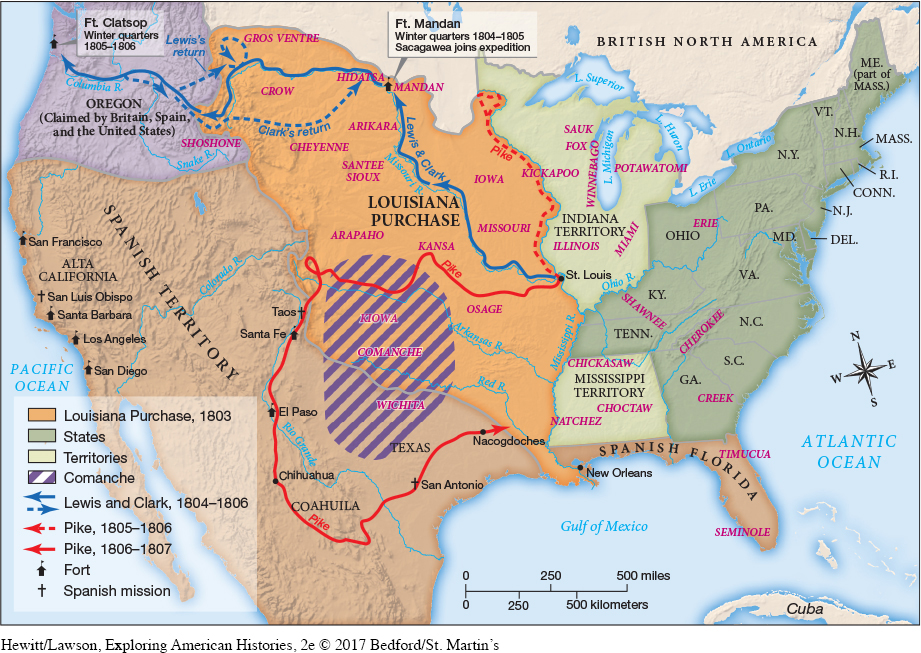Acquiring the Louisiana Territory
In France’s defeat Jefferson saw an opportunity to gain navigation rights on the Mississippi River, which the French controlled. This was a matter of crucial concern to Americans living west of the Appalachian Mountains. Jefferson sent James Monroe to France to offer Napoleon $2 million to ensure Americans the right of navigation and deposit (i.e., offloading cargo from ships) on the Mississippi. To Jefferson’s surprise, Napoleon offered instead to sell the entire Louisiana Territory for $15 million.
The president agonized over the constitutionality of this Louisiana Purchase. Since the Constitution contained no provisions for buying land from foreign nations, a strict interpretation would prohibit the purchase. In the end, though, the opportunity proved too tempting, and the president finally agreed to buy the Louisiana Territory. Jefferson justified his decision by arguing that the territory would allow for the removal of more Indians from east of the Mississippi River, end European influence in the region, and expand U.S. trade networks. Opponents viewed the purchase as benefiting mainly agrarian interests and suspected Jefferson of trying to offset Federalist power in the Northeast. Neither party seemed especially concerned about the French, Spanish, or native peoples living in the region. They came under U.S. control when the Senate approved the purchase in October 1803. And the acquisition proved popular among ordinary Americans, most of whom focused on the opportunities it offered rather than the expansion of federal power it ensured.
At Jefferson’s request, Congress had already appropriated funds for an expedition known as the Corps of Discovery to explore territory along the Missouri River. That expedition could now explore much of the Louisiana Territory. The president’s personal secretary, Meriwether Lewis, headed the venture and invited fellow Virginian William Clark to serve as co-captain. The two set off with about forty-five men on May 14, 1804. For two years, they traveled thousands of miles up the Missouri River, through the northern plains, over the Rocky Mountains, and beyond the Louisiana Territory to the Pacific coast. Sacagawea and her husband joined them in April 1805 as they headed into the Rocky Mountains. Throughout the expedition, members meticulously recorded observations about local plants and animals as well as Indian residents, providing valuable evidence for young scientists like Parker Cleaveland and fascinating information for ordinary Americans. See Document Project 8: The Corps of Discovery: Paeans to Peace and Instruments of War.
Sacagawea was the only Indian to travel as a permanent member of the expedition, but many other native women and men assisted the Corps when it journeyed near their villages. They provided food and lodging for the Corps, hauled baggage up steep mountain trails, and traded food, horses, and other items. The one African American on the expedition, a slave named York, also helped negotiate trade with local Indians. York, who realized his value as a trader, hunter, and scout, asked Clark for his freedom when the expedition ended in 1806. York did eventually become a free man, but it is not clear whether it was by Clark’s choice or York’s escape.
Other expeditions followed Lewis and Clark’s venture. In 1806 Lieutenant Zebulon Pike led a group to explore the southern portion of the Louisiana Territory (Map 8.1). After traveling from St. Louis to the Rocky Mountains, the expedition entered Mexican territory. In early 1807, Pike and his men were captured by Mexican forces. They were returned to the United States at the Louisiana border that July. Pike had learned a great deal about lands that would eventually become part of the United States and about Mexican desires to overthrow Spanish rule, information that proved valuable over the next two decades.

Early in this series of expeditions, in November 1804, Jefferson easily won reelection as president. His popularity among farmers, already high, increased when Congress reduced the minimum allotment for federal land sales from 320 to 160 acres. This act allowed more farmers to purchase land on their own rather than via speculators. Yet by the time of Jefferson’s second inauguration in March 1805, the president’s vision of limiting federal power had been shattered by his own actions and those of the Supreme Court.
Exploring American HistoriesPrinted Page 254
Exploring American Histories Value EditionPrinted Page 188
Chapter Timeline